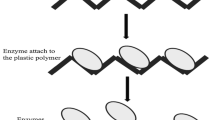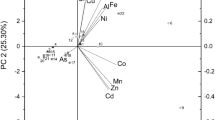Abstract
Pelagic Sargassum is considered an ecological plague that is causing adverse economic impacts to the tourist and fishing industries in the Caribbean. However, its proliferation might be playing an important role to reduce global warming, as it removes a high content of CO2 from the atmosphere and transforms it into calcium carbonate, in its calcite phase, producing sediment after it dies. We quantified the amount of calcite in Sargassum samples collected from the Mexican Caribbean coast in 2019. Samples were divided into three parts: vesicles, thallus, and leaves. In each part, the amount of carbon, oxygen, and calcium was determined by means of X-ray energy dispersion to confirm the existence of a calcite crystalline phase. Imaging methodologies and IR spectroscopy complemented the structural studies. The thermogravimetric analysis determined that approximately 5% of the CO2 captured by the Sargassum was converted into calcite. Thus, by extrapolation, the Atlantic Sargasso Belt retained approximately 19.3 million tons of CO2 from 2011 to 2019.






Similar content being viewed by others
References
Abbott, I. A., Isabella, A., & Hollenberg, G. J. Marine algae of California. Stanford University Press; 1992
Abou-El-Wafa, G. S., Shaaban, K. A., El-Naggar, M. E., & Shaaban. A. Bioactive constituents and biochemical composition of the Egyptian brown alga Sargassum subrepandum (Forsk). Rev Latinoam química 2011;39(1–2):62–74
Baer, Julia; Stengel, Dagmar B. Variability in growth, development and reproduction of the non-native seaweed Sargassum muticum (Phaeophyceae) on the Irish west coast. EstuarineCoastal and Shelf Science, 2010; 90 (4):185–194
Barsanti W (2006) In: Barsanti L, Gualtieri P (eds) Algae—anatomy, biochemistry, and biotechnology. CRC press, Taylor & Francis, Boca Raton, London, p 320pp
Bird KT, Chynoweth DP, Jerger DE (1990) Effects of marine algal proximate composition on methane yields. J Appl Phycol 2(3):207–213. https://doi.org/10.1007/BF02179777
Casas Valdez M et al (2006) El alga marina Sargassum (Sargassaceae): una alternativa tropical para la alimentación de ganado caprino. Rev Biol Trop 54(1):83–92
Cinvestav. https://avanceyperspectiva.cinvestav.mx/sargazo-conociendo-al-enemigo/. Consulted in January 2019
Cuezva S, García-Guinea J, Fernandez-Cortes A, Benavente D, Ivars J, Galan JM, Sanchez-Moral S (2016) Composition, uses, provenance and stability of rocks and ancient mortars in a Theban tomb in Luxor (Egypt). Mater Struct 49(3):941–960. https://doi.org/10.3844/ajessp.2017.58.64
Fabry VJ, Deuser WG (1991) Aragonite and magnesian calcite fluxes to the deep Sargasso Sea. Deep Sea research part a. Oceanographic Research Papers 38(6):713–728
Fragoso D, Ramirez-Cahero F, Rodriguez-Galvan A et al (2010) Characterization of the CaCO3 biomineral in coralline red algae (Corallinales) from the Pacific coast of Mexico Caracterización del biomineral CaCO3 en algas Rojas coralinas (Corallinales) de las costas del Pacífico Mexicano. Ciencias Mar 36(1):41–58
Galván-Ruiz, M., Hernández, J., Baños, L., Noriega-Montes, J., & Rodríguez- García, M. E. Characterization of calcium carbonate, calcium oxide, and calcium hydroxide as starting point to the improvement of lime for their use in construction. J Mater Civ Eng 2009; 21(11), 694–698
Hu C et al. (2016) Sargassum watch warns of incoming seaweed. EOS, Published on 02 September 2016. https://doi.org/10.1029/2016EO058355
Louime C, Fortune J, Gervais G (2017) Sargassum invasion of coastal environments: a growing concern. Am J Environ Sci 13(1):58–64
Moanga, D. A. (2015). Karenia Brevis hot spots in the West Florida shelf and their associated socioeconomic implications
Muñoz Bautista A.N. Composición Taxonómica y Abundancia de la Macrofauna Asociada a Sargassum (Phaeophyceae: Fucales) Flotante en el Sistema Arrecifal Veracruzano, Suroeste del Golfo de México 2013:54
Murakami K, Yamaguchi Y, Noda K, Fujii T, Shinohara N, Ushirokawa T, Sugawa-Katayama Y, Katayama M (2011) Seasonal variation in the chemical composition of a marine brown alga, Sargassum horneri (turner) C. Agardh J Food Compos Anal 24(2):231–236. https://doi.org/10.1016/j.jfca.2010.08.004
NOAA. https://www.esrl.noaa.gov/gmd/ccgg/trends/ Consulted in March 2020
Noah AZ, El Semary MA, Youssef AM, El-Safty MA (2017) Enhancement of yield point at high pressure high temperature wells by using polymer nanocomposites based on ZnO & CaCO3 nanoparticles. Egypt J Pet 26(1):33–40. https://doi.org/10.1016/j.ejpe.2016.03.002
Noiraksar, T., & Ajisaka, T. Taxonomy and distribution of Sargassum (Phaeophyceae) in the Gulf of Thailand. In Nineteenth International Seaweed Symposium (pp. 513–527). Springer, Dordrecht. 2008
NYT.https://www.nytimes.com/es/2019/08/16/espanol/america-latina/ sargazoplayas-mexico.html. Consulted in September 2019
Peng Y, Xie E, Zheng K, Fredimoses M, Yang X, Zhou X, Wang Y, Yang B, Lin X, Liu J, Liu Y (2013) Nutritional and chemical composition and antiviral activity of cultivated seaweed Sargassum naozhouense Tseng et Lu. Mar Drugs 11(1):20–32. https://doi.org/10.3390/md11010020
Pérez-Salcedo KY, Alonso-Lemus IL, Quintana P, Mena-Durán CJ, Barbosa R, Escobar B (2019) Self-doped Sargassum spp. derived biocarbon as electrocatalysts for ORR in alkaline media. Int J Hydrog Energy 44(24):12399–12408. https://doi.org/10.1016/j.ijhydene.2018.10.073
Rajvanshi S, Sharma MP (2012) Micro algae: a potential source of biodiesel. J Sustain Bioenergy Syst 02(03):49–59. https://doi.org/10.4236/jsbs.2012.23008
Ramanan R, Kannan K, Deshkar A, Yadav R, Chakrabarti T (2010) Enhanced algal CO2 sequestration through calcite deposition by Chlorella sp. and Spirulina platensis in a mini-raceway pond. Bioresour Technol 101(8):2616–2622. https://doi.org/10.1016/j.biortech.2009.10.061
Smith JE, Hunter CL, Smith CM (2002) Distribution and reproductive characteristics of nonindigenous and invasive marine algae in the Hawaiian islands. Pacific Sci 56(3):299–315. https://doi.org/10.1353/psc.2002.0030
Sviben S, Gal A, Hood MA et al (2016) A vacuole-like compartment concentrates a disordered calcium phase in a key coccolithophorid alga. Nat Commun 7:1–9. https://doi.org/10.1038/ncomms11228
Tran TN, Pham TVA, Le MLP, Nguyen TPT, Tran VM (2013) Synthesis of amorphous silica and sulfonic acid functionalized silica used as reinforced phase for polymer electrolyte membrane. Adv Nat Sci Nanosci Nanotechnol 4(4). https://doi.org/10.1088/2043-6262/4/4/045007
Tumuluru JS, Hess JR, Boardman RD, Wright CT, Westover TL (2012) Formulation, pretreatment, and densification options to improve biomass specifications for Cofiring high percentages with coal. Ind Biotechnol 8(3):113–132. https://doi.org/10.1089/ind.2012.0004
USF.(2020) University of south Florid. https://optics.marine.usf.edu/. Consulted in March 2020
van Tussenbroek BI, Hernández Arana HA, Rodríguez-Martínez RE, Espinoza-Avalos J, Canizales-Flores HM, González-Godoy CE, Barba-Santos MG, Vega-Zepeda A, Collado-Vides L (2017) Severe impacts of brown tides caused by Sargassum spp. on near-shore Caribbean seagrass communities. Marine Pollution Bulletin 122 (1–2):272–281
Veiga P, Torres AC, Besteiro C, Rubal M (2018) Mollusc assemblages associated with invasive and native Sargassum species. Cont Shelf Res 161(April):12–19. https://doi.org/10.1016/j.csr.2018.04.011
Vijayanand N, Ramya SS, Rathinavel S (2014) Potential of liquid extracts of Sargassum wightii on growth, biochemical and yield parameters of cluster bean plant. Asian Pacific J Reprod 3(2):150–155. https://doi.org/10.1016/S2305-0500(14)60019-1
Vijayaraghavan K, Padmesh TVN, Palanivelu K, Velan M (2006) Biosorption of nickel (II) ions onto Sargassum wightii: application of two-parameter and three-parameter isotherm models. J Hazard Mater 133(1–3):304–308. https://doi.org/10.1016/j.jhazmat.2005.10.016
Wang M, Hu C, Barnes BB, Mitchum G, Lapointe B, Montoya JP (2019) The great Atlantic Sargassum belt. Science (80-). 364(6448):83–87. https://doi.org/10.1126/science.aaw7912
Winston JE et al. (1997) Encrusters, Epibionts, and Other Biota Associated with Pelagic Plastics: a Review of Biogeographical, Environmental, and Conservation Issues. Marine Debris 1. https://doi.org/10.1007/978-1-4613-8486-1_9
Wong K, Cheung PC (2001) Influence of drying treatment on three Sargassum species: proximate composition, amino acid profile and some physico-chemical properties. J Appl Phycol 13(1):43–50. https://doi.org/10.1023/A:1008149215156
Yang W, Liu Z, Xu W, Liu Y (2018) Removal of elemental mercury from flue gas using sargassum chars modified by NH 4 Br reagent. Fuel. 214(November 2017):196–206. https://doi.org/10.1016/j.fuel.2017.11.004
Zubia M, Payri CE, Deslandes E, Guezennec J (2003) Chemical composition of attached and drift specimens of Sargassum mangarevense and Turbinaria ornata (Phaeophyta: Fucales) from Tahiti. French Polynesia Bot Mar 46(6):562–571. https://doi.org/10.1515/BOT.2003.059
Acknowledgments
The authors wish to thank and acknowledge L. de La Torre for his technical analysis. Thanks to K. Campos and E. Lestarjette for their help with SEM and XRD data acquisition, Nanotech National Laboratory and COLCIENCIAS (Administrative Department of Science, Technology and Innovation) Colombia. Thanks to Fabiola Paraguay-Ureta for manuscript review.
Author information
Authors and Affiliations
Corresponding author
Additional information
Responsible Editor: Philippe Garrigues
Publisher’s note
Springer Nature remains neutral with regard to jurisdictional claims in published maps and institutional affiliations.
Rights and permissions
About this article
Cite this article
Paraguay-Delgado, F., Carreño-Gallardo, C., Estrada-Guel, I. et al. Pelagic Sargassum spp. capture CO2 and produce calcite. Environ Sci Pollut Res 27, 25794–25800 (2020). https://doi.org/10.1007/s11356-020-08969-w
Received:
Accepted:
Published:
Issue Date:
DOI: https://doi.org/10.1007/s11356-020-08969-w




